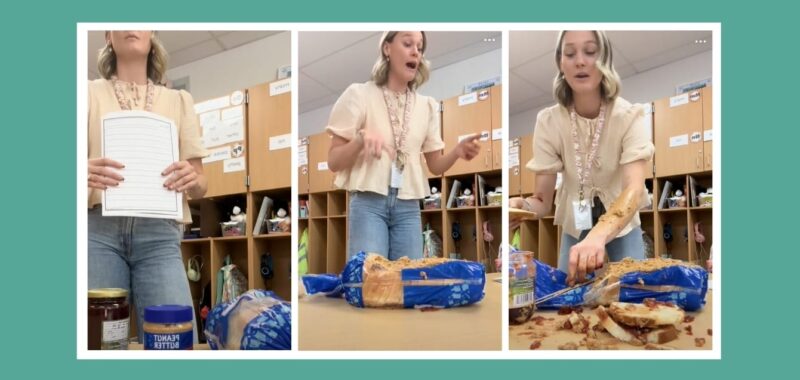The most memorable lessons rarely come from textbooks or worksheets. Just ask any adult what they remember from elementary school, and you’ll likely hear about the teacher who dressed as a historical figure, the explosive science experiment that stained the ceiling, or the day everyone got to eat what they were studying.
First-grade teacher Kayleigh Sloan knows this educational truth well. In a TikTok video that’s rapidly winning the hearts of parents and educators alike, she transforms a potentially dry writing lesson about descriptive language into an unforgettable, laugh-out-loud experience involving bread bags, globs of peanut butter, and jelly-covered arms.
Related: Pregnant teacher pauses math lesson to share a moment with her baby—her students’ reaction says it all
Her approach? Take her students’ written instructions for making a peanut butter and jelly sandwich and follow them literally—with hilariously messy results that brilliantly demonstrate why details matter in writing.
When “put on the jelly” goes terribly wrong
Picture this: A classroom of first graders watching in horror as their teacher smears peanut butter and jelly directly onto her arms because one student’s instructions simply said to “put on the peanut butter.” Or imagine the chorus of “NOOOOO!” as she keeps bread in the bag while spreading ingredients on it with her bare hands.
“It’s like a wonderful moisturizer,” Sloan quips as peanut butter drips down her arm, while her students dissolve into giggles and frantic attempts to correct her instructions.
This isn’t just a teacher being silly—it’s a masterclass in why details matter when we communicate. As her first graders watched their sandwich-making instructions taken literally, they got a lesson they’ll never forget about descriptive writing.
The Amelia Bedelia method works
If this approach seems familiar, you might be thinking of the beloved children’s book character Amelia Bedelia, famous for following instructions too literally—dusting by throwing dust around or dressing the chicken in tiny clothes.
What makes Sloan’s method brilliant is how it taps into what educators know about memorable learning experiences: When instruction involves humor, surprise, and active participation, the lesson sticks. These first graders will likely never forget to include detailed steps in their writing again after watching their teacher spread peanut butter on the outside of a bread bag.
By the end of the video, her students are enthusiastically offering improved instructions: “Put bread on the plate, grab the knife, scoop some peanut butter, then put it on the bread.”
Why this matters beyond the classroom
While watching a teacher smear peanut butter on her arms is hilarious for 6-year-olds, the core lesson applies at home too—perhaps even more so.
As parents of elementary schoolers know all too well, the land of incomplete stories and jumbled explanations can make communication feel like solving a mystery sometimes. “What did you do at school today?” “Stuff.” “How did you get that scratch?” “I don’t remember.” Sound familiar?
The ability to communicate clearly with specific details isn’t just about academic writing—it’s a life skill that affects everything from explaining problems to building confidence in self-expression.
Bringing the PB&J method home
Ready to channel your inner Ms. Sloan? Here are three ways to adapt this classroom technique for home use with elementary-aged kids:
1. Try reverse instruction
Have your child write instructions for something simple (making a sandwich, building with blocks, or drawing a picture). Then follow their directions EXACTLY as written—no filling in gaps or making assumptions. The results will likely highlight where details were missing.
This works wonderfully with elementary schoolers because it becomes a hilarious game rather than a boring writing exercise. Plus, the inevitable laughter creates a positive association with improving their communication skills.
2. Play “robot parent”
Transform into a “robot” who only understands very specific instructions. Ask your child to guide you through a simple task like putting away toys or setting the table. Respond only to their exact words, taking everything literally.
When they say “put the spoon there,” place it exactly where they’re pointing without assuming which direction it should face. The giggles that follow when you put a spoon upside-down or sideways teach the importance of specific directions more powerfully than any worksheet.
3. Use recipe development as communication practice
Cooking together offers natural opportunities to practice descriptive communication. Have your child create an original recipe (even something simple like a yogurt parfait or silly sandwich) and write or dictate detailed instructions.
Then, the true test: follow those exact instructions to see if you can recreate their culinary masterpiece. The immediate feedback loop shows the importance of clarity and specific details—plus they get to enjoy eating their creation afterward!
The lasting lesson
What makes Sloan’s lesson so effective is how it creates an immediate, visual consequence for unclear communication. When instructions lack detail, peanut butter ends up places it shouldn’t be.
In our increasingly complex world, where kids need to navigate everything from classroom instructions to explaining their needs and feelings, the ability to express themselves clearly and specifically matters more than ever. While they might groan at the idea of “another writing lesson,” approaching it with humor and hands-on activities can transform it into a favorite family game.
And if all else fails, there’s always the option of dramatically misinterpreting their vague instructions until they learn to be more specific. Just keep the peanut butter jar handy—and maybe some extra napkins.
Have you tried any creative techniques to help your kids communicate more clearly? Share your experiences in the comments!
Related: Teacher pulls mom aside after school—what her son said left her speechless

